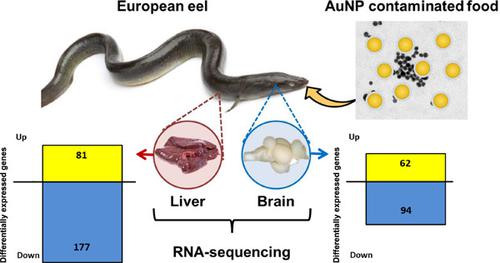当前位置:
X-MOL 学术
›
Environ. Toxicol. Chem.
›
论文详情
Our official English website, www.x-mol.net, welcomes your
feedback! (Note: you will need to create a separate account there.)
Transfer and Transcriptomic Profiling in Liver and Brain of European Eels Anguilla anguilla After Diet-borne Exposure to Gold Nanoparticles.
Environmental Toxicology and Chemistry ( IF 3.6 ) Pub Date : 2020-08-24 , DOI: 10.1002/etc.4858 Fanny Perrier 1 , Anthony Bertucci 1 , Fabien Pierron 1 , Agnès Feurtet-Mazel 1 , Olivier Simon 2 , Christophe Klopp 3 , Frédéric Candaudap 4 , Oleg Pokrovski 4 , Bruno Etcheverria 1 , Stéphane Mornet 5 , Magalie Baudrimont 1
Environmental Toxicology and Chemistry ( IF 3.6 ) Pub Date : 2020-08-24 , DOI: 10.1002/etc.4858 Fanny Perrier 1 , Anthony Bertucci 1 , Fabien Pierron 1 , Agnès Feurtet-Mazel 1 , Olivier Simon 2 , Christophe Klopp 3 , Frédéric Candaudap 4 , Oleg Pokrovski 4 , Bruno Etcheverria 1 , Stéphane Mornet 5 , Magalie Baudrimont 1
Affiliation

|
A nanometric revolution is underway, promising technical innovations in a wide range of applications and leading to a potential boost in environmental discharges. The propensity of nanoparticles (NPs) to be transferred throughout trophic chains and to generate toxicity was mainly assessed in primary consumers, whereas a lack of knowledge for higher trophic levels persists. The present study focused on a predatory fish, the European eel (Anguilla anguilla) exposed to gold NPs (AuNPs; 10 nm, polyethylene glycol–coated) for 21 d at 3 concentration levels in food: 0 (NP0), 1 (NP1), and 10 (NP10) mg Au kg−1. Transfer was assessed by Au quantification in eel tissues, and transcriptomic responses in the liver and brain were revealed by a high‐throughput RNA‐sequencing approach. Eels fed at NP10 presented an erratic feeding behavior, whereas Au quantification only indicated transfer to intestine and kidney of NP1‐exposed eels. Sequencing of RNA was performed in NP0 and NP1 eels. A total of 258 genes and 156 genes were significantly differentially transcribed in response to AuNP trophic exposure in the liver and brain, respectively. Enrichment analysis highlighted modifications in the immune system–related processes in the liver. In addition, results pointed out a shared response of both organs regarding 13 genes, most of them being involved in immune functions. This finding may shed light on the mode of action and toxicity of AuNPs in fish. Environ Toxicol Chem 2020;39:2450–2461. © 2020 SETAC
中文翻译:

饮食性接触金纳米颗粒后欧洲鳗鳗的肝脏和大脑的转移和转录组分析。
纳米技术革命正在进行中,有望在广泛的应用领域进行技术创新,并有可能促进环境排放。主要在主要消费者中评估了纳米粒子(NPs)在整个营养链中转移并产生毒性的倾向,而仍然缺乏对较高营养水平的知识。本研究的重点是掠食性鱼类,欧洲鳗鱼(Anguilla anguilla)在食物中的3种浓度水平下暴露于金NPs(AuNPs; 10 nm,聚乙二醇涂层)21 d:0(NP0),1(NP1)和10(NP10)mg Au kg -1。通过鳗鱼组织中的Au定量评估转移,通过高通量RNA测序方法揭示肝脏和大脑中的转录组反应。以NP10喂养的鳗鱼表现出不稳定的喂养行为,而Au定量仅表明暴露于NP1的鳗鱼转移到肠和肾。在NP0和NP1鳗鱼中进行RNA测序。分别对肝脏和大脑中的AuNP营养暴露,总共显着差异地转录了258个基因和156个基因。富集分析强调了肝脏免疫系统相关过程的改变。此外,结果指出了两个器官对13个基因的共同反应,其中大多数参与免疫功能。这一发现可能为AuNPs在鱼类中的作用方式和毒性提供了启示。环境毒性化学2020; 39:2450–2461。©2020 SETAC
更新日期:2020-08-24
中文翻译:

饮食性接触金纳米颗粒后欧洲鳗鳗的肝脏和大脑的转移和转录组分析。
纳米技术革命正在进行中,有望在广泛的应用领域进行技术创新,并有可能促进环境排放。主要在主要消费者中评估了纳米粒子(NPs)在整个营养链中转移并产生毒性的倾向,而仍然缺乏对较高营养水平的知识。本研究的重点是掠食性鱼类,欧洲鳗鱼(Anguilla anguilla)在食物中的3种浓度水平下暴露于金NPs(AuNPs; 10 nm,聚乙二醇涂层)21 d:0(NP0),1(NP1)和10(NP10)mg Au kg -1。通过鳗鱼组织中的Au定量评估转移,通过高通量RNA测序方法揭示肝脏和大脑中的转录组反应。以NP10喂养的鳗鱼表现出不稳定的喂养行为,而Au定量仅表明暴露于NP1的鳗鱼转移到肠和肾。在NP0和NP1鳗鱼中进行RNA测序。分别对肝脏和大脑中的AuNP营养暴露,总共显着差异地转录了258个基因和156个基因。富集分析强调了肝脏免疫系统相关过程的改变。此外,结果指出了两个器官对13个基因的共同反应,其中大多数参与免疫功能。这一发现可能为AuNPs在鱼类中的作用方式和毒性提供了启示。环境毒性化学2020; 39:2450–2461。©2020 SETAC











































 京公网安备 11010802027423号
京公网安备 11010802027423号